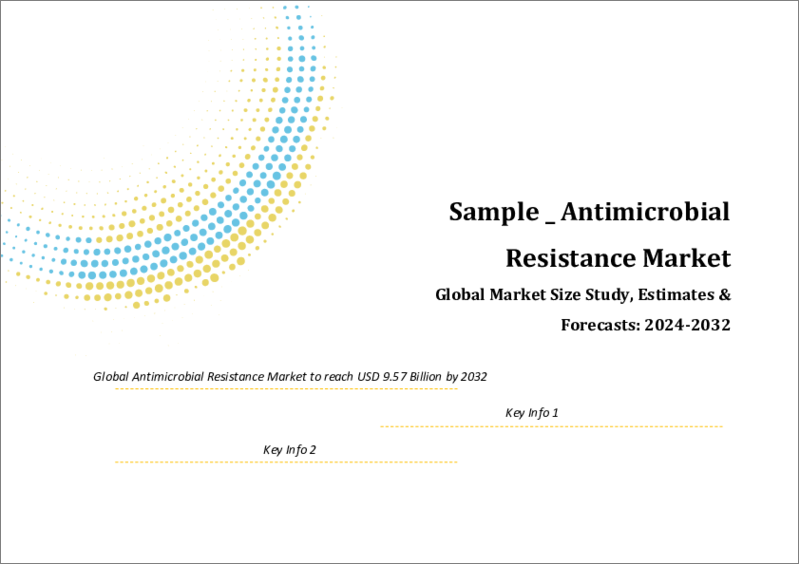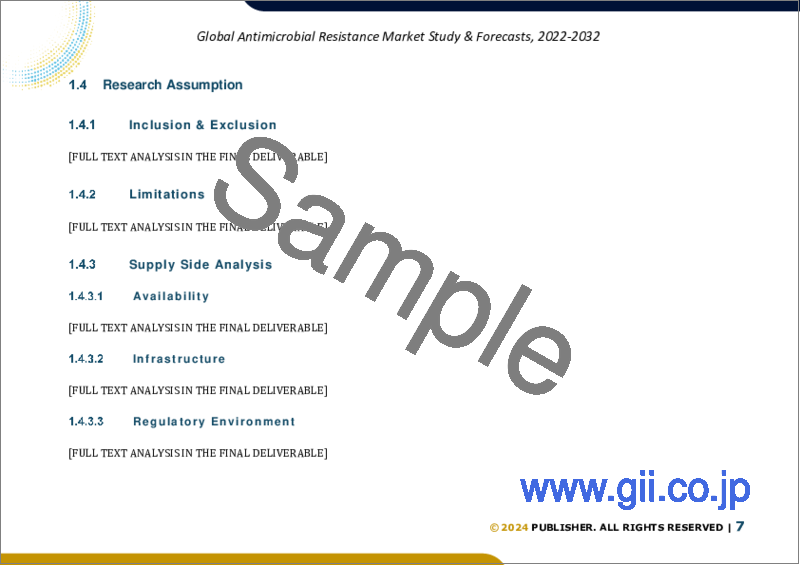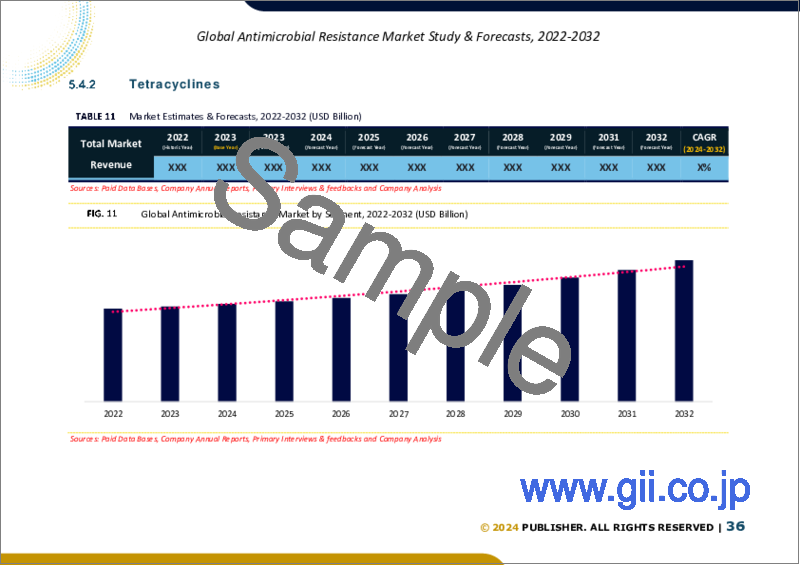|
|
市場調査レポート
商品コード
1525305
抗菌薬耐性の世界市場規模調査、薬剤クラス別、適応症別、作用機序別、地域別予測、2022年~2032年Global Antimicrobial Resistance Market Size Study, By Drug Class, By Indication, By Mechanism of Action, and Regional Forecasts 2022-2032 |
||||||
カスタマイズ可能
|
|||||||
| 抗菌薬耐性の世界市場規模調査、薬剤クラス別、適応症別、作用機序別、地域別予測、2022年~2032年 |
|
出版日: 2024年07月30日
発行: Bizwit Research & Consulting LLP
ページ情報: 英文 285 Pages
納期: 2~3営業日
|
- 全表示
- 概要
- 目次
世界の抗菌薬耐性市場は、2023年に約49億5,000万米ドルと評価され、予測期間2024-2032年には7.6%以上の健全な成長率で成長すると予測されています。
抗菌薬耐性(AMR)は、主に抗生物質の誤用と過剰使用によって引き起こされる、現代のヘルスケアにおける重大な課題です。この誤用は、特に規制の枠組みが脆弱であったり、施行が不十分であったりすることが多い中低所得国で横行しており、抗生物質の過剰処方や規制のない使用につながっています。その結果、耐性菌感染症に対抗できる新規抗生物質の需要が高まっています。抗菌薬耐性を克服できる新しい抗生物質の緊急の必要性は、既存の薬剤が効かなくなってきていることに起因しています。このような耐性菌の発生は、多大な経済的コストとヘルスケアシステムへの大きな負担をもたらし、しばしば入院期間の延長や集中治療の必要性をもたらします。抗菌薬耐性は、細菌、真菌、ウイルスなどの微生物が、それらを殺すために設計された薬剤に対して耐性を獲得することで生じ、感染症の治療を困難にし、疾病の拡大、重症化、死亡のリスクを高めることで、世界の健康に深刻な脅威をもたらします。
抗菌薬耐性市場の成長を促進する要因はいくつかあります。抗生物質の誤用や過剰使用は、治療困難な細菌感染症の有病率の上昇と相まって、主要な促進要因となっています。世界保健機関(WHO)は、抗菌薬耐性を世界の公衆衛生の脅威トップ10の1つとして取り上げ、新規抗生物質の緊急の必要性を強調しています。耐性菌による尿路感染症(cUTI)や院内肺炎などの課題は、治療法の選択肢が限られている病原体によるものであるため、これらの重要なニーズに対応するための新規抗生物質の開発が必要となっています。市場は、新規抗生物質の開発・上市に注力する主な企業による多額の投資によっても支えられています。Dificid、Recarbrio、Zerbaxaなどの製品は、耐性菌に対する有効性を背景に、先進国や一部の発展途上国で採用が進んでいます。しかし、複雑な研究開発プロセスや厳しい規制により、これらの新規抗生物質には高いコストがかかるため、市場の大きな抑制要因となっています。さらに、抗生物質耐性に対する認識が高まり、新規抗生物質の開発に多額の資金が投入されるようになったことも、有利な成長機会をもたらしています。主要企業間の共同研究やパートナーシップは、市場の展望をさらに後押ししています。
抗菌薬耐性市場の主要地域には、北米、欧州、アジア太平洋、ラテンアメリカ、中東・アフリカが含まれます。2023年には、北米が抗菌薬耐性市場を独占します。これは、主要な業界プレイヤーの存在、高度なヘルスケアインフラ、新規抗生物質の上市に起因します。米国とカナダを拠点とする大手製薬会社は、創薬と臨床試験への多額の投資に支えられ、抗生物質と代替療法の技術革新を先導しています。さらに、北米の厳格な規制の枠組みにより、新規抗菌薬の厳格な試験と承認プロセスが保証され、高い水準の有効性と安全性が維持されています。さらに、同大陸では、耐性病原体の増加を抑制することを目的として、責任ある抗菌薬の使用と感染予防戦略を強調する啓発キャンペーンや公衆衛生の取り組みが広く行われています。アジア太平洋地域は、抗生物質の過剰な誤用、ヘルスケア意識の高まり、インドや中国のような国々における新規抗生物質の採用が原動力となり、最も高い成長率を示すと予想されます。
目次
第1章 世界の抗菌薬耐性市場エグゼクティブサマリー
- 抗菌剤耐性の世界市場規模・予測(2022-2032年)
- 地域別概要
- セグメント別概要
- 薬剤クラス別
- 適応症別
- 作用機序別
- 病原体別
- 主要動向
- 景気後退の影響
- アナリストの結論・提言
第2章 世界の抗菌薬耐性市場の定義と調査前提条件
- 調査目的
- 市場の定義
- 調査前提条件
- 包含と除外
- 制限事項
- 供給サイドの分析
- 入手可能性
- インフラ
- 規制環境
- 市場競争
- 経済性(消費者の視点)
- 需要サイド分析
- 規制の枠組み
- 技術の進歩
- 環境への配慮
- 消費者の意識と受容
- 調査手法
- 調査対象年
- 通貨換算レート
第3章 抗菌剤耐性の世界市場力学
- 市場促進要因
- 抗生物質の誤用と過剰使用
- 耐性菌感染の増加
- 新規抗生物質に対する需要の増加
- 市場の課題
- 新規抗生物質の高コスト
- 抗生物質開発における規制上のハードル
- 市場機会
- 抗生物質開発における技術の進歩
- 資金調達と共同研究の増加
第4章 世界の抗菌薬耐性市場産業分析
- ポーターのファイブフォースモデル
- 供給企業の交渉力
- 買い手の交渉力
- 新規参入業者の脅威
- 代替品の脅威
- 競争企業間の敵対関係
- ポーターのファイブフォースモデルへの未来的アプローチ
- ポーターのファイブフォースの影響分析
- PESTEL分析
- 政治
- 経済
- 社会
- 技術
- 環境
- 法律
- 主な投資機会
- 主要成功戦略
- 破壊的動向
- 業界専門家の視点
- アナリストの結論・提言
第5章 抗菌薬耐性の世界市場規模・予測:薬剤クラス別-2022年~2032年
- セグメントダッシュボード
- 世界の抗菌薬耐性市場薬剤クラス別収益動向分析、2022年および2032年
- 併用療法
- テトラサイクリン
- セファロスポリン
- 糖ペプチドおよび脂肪糖ペプチド
- オキサゾリジノン
- その他
第6章 抗菌薬耐性の世界市場規模・予測:適応症別-2022年~2032年
- セグメントダッシュボード
- 抗菌薬耐性の世界市場2022年および2032年の適応症別収益動向分析
- 合併症性尿路感染症(cUTI)
- 血流感染症
- 急性細菌性皮膚・皮膚構造感染症(ABSSSI)
- 病院後天性細菌性肺炎および人工呼吸器後天性細菌性肺炎(HABPおよびVABP)
- 市中肺炎(CAP)
- その他
第7章 抗菌薬耐性の世界市場規模・予測:作用機序別-2022年~2032年
- セグメントダッシュボード
- 抗菌薬耐性の世界市場作用機序別収益動向分析、2022年・2032年
- タンパク質合成阻害剤
- 細胞壁合成阻害剤
- その他
第8章 抗菌薬耐性の世界市場規模・予測:病原体別-2022年・2032年
- セグメントダッシュボード
- 世界の抗菌薬耐性市場病原体収益動向分析、2022年・2032年
- 大腸菌
- 肺炎桿菌
- 緑膿菌
- 黄色ブドウ球菌
- 腸球菌属
- その他
第9章 抗菌薬耐性の世界市場規模・予測:地域別-2022年~2032年
- 北米
- 米国
- カナダ
- 欧州
- 英国
- ドイツ
- フランス
- スペイン
- イタリア
- その他欧州
- アジア太平洋
- 中国
- インド
- 日本
- オーストラリア
- 韓国
- その他アジア太平洋
- ラテンアメリカ
- ブラジル
- メキシコ
- その他ラテンアメリカ
- 中東・アフリカ
- サウジアラビア
- 南アフリカ
- その他中東・アフリカ
第10章 競合情報
- 主要企業のSWOT分析
- 主要市場戦略
- 企業プロファイル
- Alkem Laboratories Ltd
- 主要情報
- 概要
- 財務(データの入手可能性によります)
- 製品概要
- 市場戦略
- Innoviva, Inc.
- Pfizer Inc.
- Merck & Co., Inc.
- Acurx Pharmaceuticals, Inc.
- Basilea Pharmaceutica Ltd
- Cumberland Pharmaceuticals Inc.
- Wockhardt Limited
- Paratek Pharmaceuticals, Inc.
- Nabriva Therapeutics plc
- Alkem Laboratories Ltd
第11章 調査プロセス
- 調査プロセス
- データマイニング
- 分析
- 市場推定
- 検証
- 出版
- 調査属性
Global Antimicrobial Resistance Market is valued approximately at USD 4.95 billion in 2023 and is anticipated to grow with a healthy growth rate of more than 7.6% over the forecast period 2024-2032. Antimicrobial resistance (AMR) represents a profound challenge in contemporary healthcare, driven predominantly by the misuse and overuse of antibiotics. This misuse is rampant, particularly in low- and middle-income countries where regulatory frameworks are often weak or poorly enforced, leading to overprescribing and unregulated antibiotic use. Consequently, this contributes to the escalating demand for novel antibiotics capable of combating resistant bacterial infections. The urgent need for new antibiotics that can overcome antimicrobial resistance stems from the growing ineffectiveness of existing drugs. This resistance incurs substantial economic costs and places significant burdens on healthcare systems, often resulting in prolonged hospital stays and intensive care requirements. Antimicrobial resistance arises when microorganisms such as bacteria, fungi, and viruses develop resistance to drugs designed to kill them, posing severe threats to global health by making infections harder to treat and increasing the risk of disease spread, severe illness, and mortality.
Several factors propel the growth of the antimicrobial resistance market. The misuse and overuse of antibiotics, combined with the rising prevalence of difficult-to-treat bacterial infections, are primary drivers. The World Health Organization (WHO) has highlighted antimicrobial resistance as one of the top ten global public health threats, underscoring the urgent need for novel antibiotics. Complicated infections such as urinary tract infections (cUTIs) and hospital-acquired pneumonias caused by resistant bacteria exemplify the challenge, as they involve pathogens with limited treatment options, necessitating the development of new antibiotics to address these critical needs. The market is also bolstered by significant investments from key players focused on developing and launching new antibiotics. Products like Dificid, Recarbrio, Zerbaxa, and others are increasingly adopted in developed and some developing countries, driven by their effectiveness against resistant bacteria. However, the high cost associated with these novel antibiotics, due to complex R&D processes and stringent regulations, poses a significant market restraint. Furthermore, increased awareness of antibiotic resistance and substantial funding for developing new antibiotics present lucrative growth opportunities. Collaborations and partnerships among key players further boost market prospects.
The key region in the Antimicrobial Resistance Market includes North America, Europe, Asia Pacific, Latin America, Middle East & Africa. In 2023, North America dominates the antimicrobial resistance market, attributed to the presence of major industry players, advanced healthcare infrastructure, and the launch of novel antibiotics. the region's robust healthcare infrastructure and advanced pharmaceutical industry enable extensive research and development in combating AMR. Leading pharmaceutical companies based in the United States and Canada spearhead innovation in antibiotics and alternative therapies, supported by significant investments in drug discovery and clinical trials. In addition, North America's stringent regulatory frameworks ensure rigorous testing and approval processes for new antimicrobial agents, maintaining high standards of efficacy and safety. Moreover, widespread awareness campaigns and public health initiatives across the continent emphasize responsible antibiotic use and infection prevention strategies, aiming to curb the rise of resistant pathogens. The Asia-Pacific region is expected to witness the highest growth rate, driven by excessive antibiotic misuse, rising healthcare awareness, and the adoption of novel antibiotic medications in countries like India and China.
Major market players included in this report are:
- Alkem Laboratories Ltd
- Innoviva, Inc.
- Pfizer Inc.
- Merck & Co., Inc.
- Acurx Pharmaceuticals, Inc.
- Basilea Pharmaceutica Ltd
- Cumberland Pharmaceuticals Inc.
- Wockhardt Limited
- Paratek Pharmaceuticals, Inc.
- Nabriva Therapeutics plc
The detailed segments and sub-segment of the market are explained below:
By Drug Class
- Combination Therapies
- Tetracyclines
- Cephalosporins
- Glycopeptides and Lipoglycopeptides
- Oxazolidinones
- Others
By Indication
- Complicated Urinary Tract Infections (cUTI)
- Blood Stream Infections
- Acute Bacterial Skin and Skin Structure Infections (ABSSSI)
- Hospital Acquired Bacterial Pneumonia and Ventilator Acquired Bacterial Pneumonia (HABP and VABP)
- Community Acquired Pneumonia (CAP)
- Others
By Mechanism of Action
- Protein Synthesis Inhibitors
- Cell Wall Synthesis Inhibitors
- Others
By Pathogen
- Klebsiella pneumoniae
- Pseudomonas aeruginosa
- Staphylococcus aureus
- Enterococcus Spp
- Others
- Escherichia coli
By Region:
- North America
- U.S.
- Canada
- Europe
- UK
- Germany
- France
- Spain
- Italy
- ROE
- Asia Pacific
- China
- India
- Japan
- Australia
- South Korea
- RoAPAC
- Latin America
- Brazil
- Mexico
- Rest of Latin America
- Middle East & Africa
- Saudi Arabia
- South Africa
- RoMEA
Years considered for the study are as follows:
- Historical year - 2022
- Base year - 2023
- Forecast period - 2024 to 2032
Key Takeaways:
- Market Estimates & Forecast for 10 years from 2022 to 2032.
- Annualized revenues and regional level analysis for each market segment.
- Detailed analysis of geographical landscape with country-level analysis of major regions.
- Competitive landscape with information on major players in the market.
- Analysis of key business strategies and recommendations on future market approach.
- Analysis of competitive structure of the market.
- Demand-side and supply-side analysis of the market.
Table of Contents
Chapter 1. Global Antimicrobial Resistance Market Executive Summary
- 1.1. Global Antimicrobial Resistance Market Size & Forecast (2022-2032)
- 1.2. Regional Summary
- 1.3. Segmental Summary
- 1.3.1. By Drug Class
- 1.3.2. By Indication
- 1.3.3. By Mechanism of Action
- 1.3.3. By Pathogen
- 1.4. Key Trends
- 1.5. Recession Impact
- 1.6. Analyst Recommendation & Conclusion
Chapter 2. Global Antimicrobial Resistance Market Definition and Research Assumptions
- 2.1. Research Objective
- 2.2. Market Definition
- 2.3. Research Assumptions
- 2.3.1. Inclusion & Exclusion
- 2.3.2. Limitations
- 2.3.3. Supply Side Analysis
- 2.3.3.1. Availability
- 2.3.3.2. Infrastructure
- 2.3.3.3. Regulatory Environment
- 2.3.3.4. Market Competition
- 2.3.3.5. Economic Viability (Consumer's Perspective)
- 2.3.4. Demand Side Analysis
- 2.3.4.1. Regulatory Frameworks
- 2.3.4.2. Technological Advancements
- 2.3.4.3. Environmental Considerations
- 2.3.4.4. Consumer Awareness & Acceptance
- 2.4. Estimation Methodology
- 2.5. Years Considered for the Study
- 2.6. Currency Conversion Rates
Chapter 3. Global Antimicrobial Resistance Market Dynamics
- 3.1. Market Drivers
- 3.1.1. Misuse and Overuse of Antibiotics
- 3.1.2. Rising Prevalence of Resistant Bacterial Infections
- 3.1.3. Increasing Demand for Novel Antibiotics
- 3.2. Market Challenges
- 3.2.1. High Cost of Novel Antibiotics
- 3.2.2. Regulatory Hurdles in Antibiotic Development
- 3.3. Market Opportunities
- 3.3.1. Technological Advancements in Antibiotic Development
- 3.3.2. Increased Funding and Collaboration
Chapter 4. Global Antimicrobial Resistance Market Industry Analysis
- 4.1. Porter's 5 Force Model
- 4.1.1. Bargaining Power of Suppliers
- 4.1.2. Bargaining Power of Buyers
- 4.1.3. Threat of New Entrants
- 4.1.4. Threat of Substitutes
- 4.1.5. Competitive Rivalry
- 4.1.6. Futuristic Approach to Porter's 5 Force Model
- 4.1.7. Porter's 5 Force Impact Analysis
- 4.2. PESTEL Analysis
- 4.2.1. Political
- 4.2.2. Economical
- 4.2.3. Social
- 4.2.4. Technological
- 4.2.5. Environmental
- 4.2.6. Legal
- 4.3. Top Investment Opportunity
- 4.4. Top Winning Strategies
- 4.5. Disruptive Trends
- 4.6. Industry Expert Perspective
- 4.7. Analyst Recommendation & Conclusion
Chapter 5. Global Antimicrobial Resistance Market Size & Forecasts by Drug Class 2022-2032
- 5.1. Segment Dashboard
- 5.2. Global Antimicrobial Resistance Market: Drug Class Revenue Trend Analysis, 2022 & 2032 (USD Billion)
- 5.2.1. Combination Therapies
- 5.2.2. Tetracyclines
- 5.2.3. Cephalosporins
- 5.2.4. Glycopeptides and Lipoglycopeptides
- 5.2.5. Oxazolidinones
- 5.2.6. Others
Chapter 6. Global Antimicrobial Resistance Market Size & Forecasts by Indication 2022-2032
- 6.1. Segment Dashboard
- 6.2. Global Antimicrobial Resistance Market: Indication Revenue Trend Analysis, 2022 & 2032 (USD Billion)
- 6.2.1. Complicated Urinary Tract Infections (cUTI)
- 6.2.2. Blood Stream Infections
- 6.2.3. Acute Bacterial Skin and Skin Structure Infections (ABSSSI)
- 6.2.4. Hospital Acquired Bacterial Pneumonia and Ventilator Acquired Bacterial Pneumonia (HABP and VABP)
- 6.2.5. Community Acquired Pneumonia (CAP)
- 6.2.6. Others
Chapter 7. Global Antimicrobial Resistance Market Size & Forecasts by Mechanism of Action 2022-2032
- 7.1. Segment Dashboard
- 7.2. Global Antimicrobial Resistance Market: Mechanism of Action Revenue Trend Analysis, 2022 & 2032 (USD Billion)
- 7.2.1. Protein Synthesis Inhibitors
- 7.2.2. Cell Wall Synthesis Inhibitors
- 7.2.3. Others
Chapter 8. Global Antimicrobial Resistance Market Size & Forecasts by Pathogen 2022-2032
- 8.1. Segment Dashboard
- 8.2. Global Antimicrobial Resistance Market: Pathogen Revenue Trend Analysis, 2022 & 2032 (USD Billion)
- 8.2.1. Escherichia coli
- 8.2.2. Klebsiella pneumoniae
- 8.2.3. Pseudomonas aeruginosa
- 8.2.4. Staphylococcus aureus
- 8.2.5. Enterococcus Spp
- 8.2.6. Others
Chapter 9. Global Antimicrobial Resistance Market Size & Forecasts by Region 2022-2032
- 9.1. North America Antimicrobial Resistance Market
- 9.1.1. U.S. Antimicrobial Resistance Market
- 9.1.1.1. Drug Class breakdown size & forecasts, 2022-2032
- 9.1.1.2. Indication breakdown size & forecasts, 2022-2032
- 9.1.1.3. Mechanism of Action breakdown size & forecasts, 2022-2032
- 9.1.2. Canada Antimicrobial Resistance Market
- 9.1.1. U.S. Antimicrobial Resistance Market
- 9.2. Europe Antimicrobial Resistance Market
- 9.2.1. U.K. Antimicrobial Resistance Market
- 9.2.2. Germany Antimicrobial Resistance Market
- 9.2.3. France Antimicrobial Resistance Market
- 9.2.4. Spain Antimicrobial Resistance Market
- 9.2.5. Italy Antimicrobial Resistance Market
- 9.2.6. Rest of Europe Antimicrobial Resistance Market
- 9.3. Asia-Pacific Antimicrobial Resistance Market
- 9.3.1. China Antimicrobial Resistance Market
- 9.3.2. India Antimicrobial Resistance Market
- 9.3.3. Japan Antimicrobial Resistance Market
- 9.3.4. Australia Antimicrobial Resistance Market
- 9.3.5. South Korea Antimicrobial Resistance Market
- 9.3.6. Rest of Asia Pacific Antimicrobial Resistance Market
- 9.4. Latin America Antimicrobial Resistance Market
- 9.4.1. Brazil Antimicrobial Resistance Market
- 9.4.2. Mexico Antimicrobial Resistance Market
- 9.4.3. Rest of Latin America Antimicrobial Resistance Market
- 9.5. Middle East & Africa Antimicrobial Resistance Market
- 9.5.1. Saudi Arabia Antimicrobial Resistance Market
- 9.5.2. South Africa Antimicrobial Resistance Market
- 9.5.3. Rest of Middle East & Africa Antimicrobial Resistance Market
Chapter 10. Competitive Intelligence
- 10.1. Key Company SWOT Analysis
- 10.2. Top Market Strategies
- 10.3. Company Profiles
- 10.3.1. Alkem Laboratories Ltd
- 10.3.1.1. Key Information
- 10.3.1.2. Overview
- 10.3.1.3. Financial (Subject to Data Availability)
- 10.3.1.4. Product Summary
- 10.3.1.5. Market Strategies
- 10.3.2. Innoviva, Inc.
- 10.3.3. Pfizer Inc.
- 10.3.4. Merck & Co., Inc.
- 10.3.5. Acurx Pharmaceuticals, Inc.
- 10.3.6. Basilea Pharmaceutica Ltd
- 10.3.7. Cumberland Pharmaceuticals Inc.
- 10.3.8. Wockhardt Limited
- 10.3.9. Paratek Pharmaceuticals, Inc.
- 10.3.10. Nabriva Therapeutics plc
- 10.3.1. Alkem Laboratories Ltd
Chapter 11. Research Process
- 11.1. Research Process
- 11.1.1. Data Mining
- 11.1.2. Analysis
- 11.1.3. Market Estimation
- 11.1.4. Validation
- 11.1.5. Publishing
- 11.2. Research Attributes






